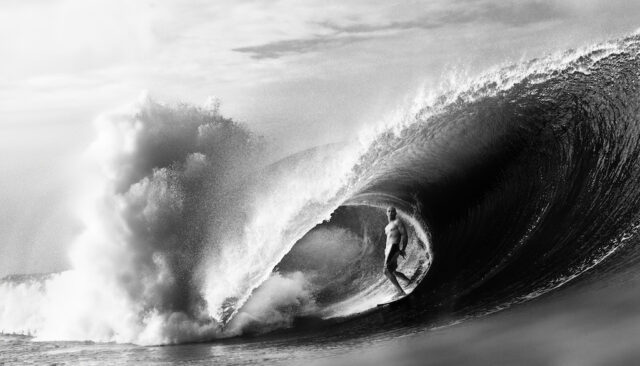
By Shaun Tomson
Kelly Slater has an interesting take on the nexus of competition and creativity. In surfing, there is a tug-of-war between competitive surfing and free surfing—surfing as an artistic and soulful endeavor unencumbered by rules, points and judging, compared with surfing as a means to achieve victory over an opponent. Some think of competition as mechanistic, without creativity, but Kelly sees his path differently.
“No one really thinks of competition as creativity,” he says. “But I’ll tell you, I feel like I was really creative competitively to be able to win as much as I was in different ways. I hate to think that, on one level, my competition record is like my best addition to the surf world. But it taught me a lot about myself, and it taught me a lot about problem-solving. What’s this challenge I have with this person? What’s this hole I’ve dug for myself here? How do I get myself out of it? There are so many times I’ve been in this situation where I’m like, ‘If I just incrementally get back in this thing, I’ll win.’”
But losses have gotten to him. In retrospect, he has adopted a philosophical perspective, viewing defeat as a learning experience. There are a couple of losses that have even been more profound to him than the wins. Dealing with the disappointment of defeat has been part of his learning and development. Every wave, every loss, every win is all part of a process of improving himself—not only as a surfer, but as a person.
But beyond the contest stats and the creative competing is the purely inspirational surfing that is often overlooked, if that can be possible. He revolutionized backside tube-riding, particularly at Pipeline. He created an entirely new drop-knee, grab-rail style that enabled him to take off far later than anyone ever before, stab the rail of the boards into the face, and slow down mid-face, holding and changing his line through the tube, turning a disadvantage into a strength. The biggest change in surfing, the fundamental shift from the all-power movement of the ’70s and ’80s, was his power-and-release approach, which entirely opened up surfing above the wave. Kelly was one of the first to regularly incorporate the aerial as a functional maneuver in his repertoire as a result of this seismic shift in his approach. He single-handedly boosted surfing into this new age; there is surfing B.K. and surfing A.K.
Riding the tube is an art form. Kelly has this special gift of slowing down time and finding his way out of seemingly impossible situations. Kelly created a whole new art form in the ’90s with a relaxed fearlessness and casual bravado, accelerating through impossible sections, at home in the eye of the hurricane.
“The tube is really the eye of the hurricane in the water,” he says. “But then you have the foam ball or tube monster, as we call it, always trying to get you, and if you can flirt with that and play with that, that’s really the ultimate barrel ride—to be able to ride on the foam ball and have your tail drift out and still have the wave pushing you along. It’s really the ultimate feeling of surfing.”
It seems there is a trend on the pro surfing tour to surf much more upright, with a more stiffened lower back, but Kelly is all rubber-like flexibility that in essence mirrors his approach to life. His style comes naturally. It is instinctive.
“Style is what naturally comes out of your body. I think to be concerned about style is kind of egocentric, to be honest with you, if it’s anything forced—if you’re trying to make it look a certain way, whether you’re going out at night and the clothes you wear, or if you are riding a wave and the way you hold your hands and your arms. If you’re doing anything besides what comes naturally, it’s not real. It’s not you. When you’re surfing, you see the wave, you stand up, you get from here to there, and the way you get from here to there without thinking about it, that’s your style, and that’s what you should stick with.”
Listening to Kelly speak, calm and unhurried, one gets the impression of thoughtfulness, humor and a sense of history. He is complex, quite guarded, severely analytical internally, humble on the exterior yet with a desire to be at the center of attention, whether in a surf contest final or just sitting on a bench with a guitar entertaining a raucous crowd throughout the night. He is goal-oriented but performance-focused, and this seems to be one of his secrets. He doesn’t have a rigid, structured plan of physical training and coaching building him toward winning the title. He has the curiosity and humility of a lifelong learner—always striving for more and to be better. Kelly lives right in that moment and that decision, and letting go of structure and the ending seems to give him peace, confidence and energy. But even with all his experience and this positive mindset, he still feels the pressure.
“I think athletes who are able to win big tournaments all have this thing where they can do it better or bigger, faster or whatever,” he says. “There’s always this constant yearning to better your performance and go somewhere you haven’t gone.”
Life has changed for Kelly now, with a baby son with his longtime partner, Kalani Miller, and a retirement announcement…although a short time later he was back competing again at Teahupo’o, and still beating some of the world’s best with an age-defying performance. It was the world’s shortest retirement. Why is Kelly still doing it, with almost everyone he knew long gone? What keeps him motivated after 56 wins and over $3 million in prize money? What keeps him going, year after year, contest after contest, when he has seemingly nothing left to prove?
He still has that intense desire to win, to show he’s still up there with the best. That fire, he freely admits, doesn’t burn quite as fiercely as before. But he still wants to progress and improve. For Kelly, being a surfing great isn’t the methodical process of beating an opponent, but rather a deep desire to show the world how good he really is—he clearly doesn’t define his surfing by contest scores but by his own impossibly high internal standard, and he seems determined to keep raising that standard. And he is searching for new inspiration.
In this complex world of ours, where we are always thinking, calculating, planning and analyzing, it is reassuring to know that for us surfers, hidden inside the tube is a simple place where we can let our instincts take over, where we can react rather than plan. It is a rare refuge where we are truly disconnected from the confusion of the world, from our cellphones, social media and computers. This is where Kelly Slater lives, in the moment, in a world of flow, where sensations are sharpened, the immediacy of life is brought into focus and all that matters is to reach for the light that is shining ahead, pulled along by an invisible hand, absolutely and unequivocally confident that it will take him to where he needs to be.
Surfer Stories: 12 Untold Stories by 12 Writers About 12 of the World’s Greatest Surfers by Claudia Lebenthal © 2025 by Regalo Press regalopress.com





